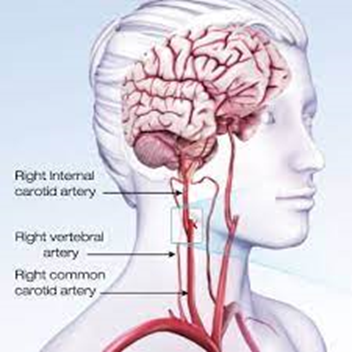A nurse is assessing a client who has multiple sclerosis. The client reports that, since the onset of the disease, there are times when their symptoms are active and then followed by a period with no symptoms. Which of the following types of multiple sclerosis does this pattern indicate?
Primary progressive multiple sclerosis
Relapsing-remitting multiple sclerosis
Clinically isolating syndrome
Secondary progressive multiple sclerosis
The Correct Answer is B
Primary progressive multiple sclerosis (PPMS) is false. This subtype of MS is characterized by a gradual worsening of symptoms from the onset of the disease, without distinct relapses or remissions. It typically leads to a progressive accumulation of disability over time, without periods of remission. The pattern described by the client, with alternating periods of active symptoms and symptom-free periods, does not align with the continuous progression seen in PPMS.
Choice B Reason:
Relapsing-remitting multiple sclerosis (RRMS) is true. RRMS is characterized by distinct relapses, during which new symptoms may appear or existing symptoms may worsen, followed by periods of partial or complete recovery (remissions), during which the symptoms improve or may even disappear entirely. This pattern matches the description provided by the client, indicating RRMS as the likely subtype.
Choice C Reason:
Clinically isolating syndrome (CIS) is false. CIS refers to a single episode of neurological symptoms caused by inflammation or demyelination in the central nervous system, which may or may not progress to MS. However, CIS does not involve the characteristic pattern of relapses and remissions seen in RRMS.
Choice D Reason:
Secondary progressive multiple sclerosis (SPMS) is false. SPMS is characterized by a gradual worsening of symptoms and disability over time, following an initial period of relapsing-remitting disease. It may or may not involve distinct relapses and remissions, depending on the individual's disease course. While SPMS can involve periods of symptom exacerbation, it typically lacks the clear pattern of relapses followed by remissions seen in RRMS.
Nursing Test Bank
Naxlex Comprehensive Predictor Exams
Related Questions
Correct Answer is C
Explanation
Choice A Reason:
Prothrombin time (PT) is a laboratory test that measures the time it takes for blood to clot is incorrect. While PT may be part of a comprehensive evaluation in some cases, it is not typically the initial diagnostic test performed for a TIA. A TIA is caused by a temporary disruption of blood flow to the brain, often due to an embolus or transient blockage in a cerebral artery, rather than a primary disorder of blood clotting.
Choice B Reason:
Complete blood count (CBC) is incorrect. A complete blood count (CBC) is a common laboratory test that evaluates the cellular components of the blood, including red blood cells, white blood cells, and platelets. While CBC can provide valuable information about hematological conditions such as anemia or thrombocytosis, it is not specific to diagnosing the cause of a TIA. TIA is primarily a vascular event related to transient ischemia in the brain rather than a disorder of blood cell counts.
Choice C Reason:
Computerized tomography angiography (CTA) is appropriate. CTA is a non-invasive imaging test that combines computed tomography (CT) scanning with contrast dye to visualize blood vessels throughout the body, including those in the brain. CTA can help identify any blockages, narrowing, or abnormalities in the blood vessels supplying the brain, which may be contributing to the TIA. It provides detailed images of the blood vessels' structure and can help guide further management and treatment decisions.
Choice D Reason:
Transesophageal echocardiogram (TEE) is inappropriate. Transesophageal echocardiogram (TEE) is an imaging test that provides detailed images of the heart and major blood vessels using sound waves. While TEE may be indicated in some cases of TIA to evaluate for potential cardiac sources of emboli (blood clots), such as atrial fibrillation or cardiac valve abnormalities, it is not typically the first-line diagnostic test performed in the emergency department setting for evaluating a TIA. Initial imaging studies such as CTA or magnetic resonance imaging (MRI) of the brain are usually prioritized to assess for acute changes in cerebral blood flow and potential causes of the TIA.

Correct Answer is B
Explanation
Choice A Reason:
Nutritional therapy is not appropriate. While nutritional therapy may be involved in assessing the client's overall nutritional status and dietary needs, it may not specifically address the swallowing difficulty associated with Parkinson's disease.
Choice B Reason:
Speech therapy is appropriate. Speech therapy, also known as speech-language pathology, plays a crucial role in assessing and managing dysphagia. Speech therapists can evaluate the client's swallowing function and provide interventions to improve swallowing safety and efficiency.
Choice C Reason:
Occupational therapy is incorrect. Occupational therapy focuses on helping individuals engage in meaningful activities of daily living. While occupational therapists may play a role in dysphagia management, speech therapy is typically the primary discipline involved in addressing swallowing difficulties.
Choice D Reason:
Respiratory therapy: Respiratory therapy primarily focuses on evaluating and managing respiratory conditions, such as asthma, chronic obstructive pulmonary disease (COPD), and ventilator support. While dysphagia can sometimes lead to aspiration pneumonia and respiratory complications, respiratory therapists are not typically involved in the assessment and management of dysphagia itself.
Whether you are a student looking to ace your exams or a practicing nurse seeking to enhance your expertise , our nursing education contents will empower you with the confidence and competence to make a difference in the lives of patients and become a respected leader in the healthcare field.
Visit Naxlex, invest in your future and unlock endless possibilities with our unparalleled nursing education contents today
Report Wrong Answer on the Current Question
Do you disagree with the answer? If yes, what is your expected answer? Explain.
Kindly be descriptive with the issue you are facing.
